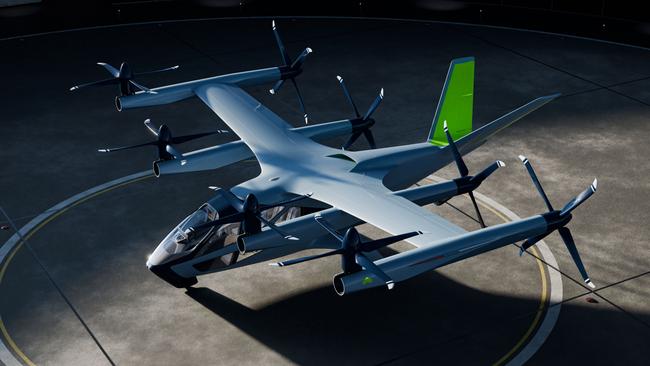Hyundai invests in air taxis as way to beat congestion
The world’s leading carmakers are investing heavily in exciting new technology designed to tackle congested city streets.
HiTech
Don't miss out on the headlines from HiTech. Followed categories will be added to My News.
“Where we’re going, we don’t need roads,” said Back to the Future’s Doc Brown. That future may be now.
Air taxis are coming, but are they the answer to our congested urban roads, or a sky-darkening nightmare of giant drones used only by the wealthy elite?
Whatever your opinion, there are big names and billions of dollars involved.
Car companies such as Toyota, Hyundai, Porsche, Mercedes-Benz and Stellantis are heavily invested, and the Advanced Air Mobility (AAM) industry is backed by aerospace giants Boeing and Airbus.
Forecasts by Morgan Stanley and Uber suggest AAM could be worth US$320 billion ($474 billion) by 2035.
Proving flying cars aren’t pie in the sky, US start-up Joby Aviation is launching air taxi services in Dubai in early 2026, its craft carrying a pilot and up to four passengers.
Australia is also on the radar for zero-emissions air taxis.

“Clustered cities with a good density of population (like Australia) is a very attractive market,” said Jaiwon Shin, President of Hyundai Motor Group and CEO of the Korean car brand’s AAM company Supernal.
“We are studying Australia because there’s strong demand (for air taxis) within one region that this vehicle can cover,” he said.
The vehicle is the S-A2 e-VTOL (electrical vertical takeoff and landing) craft.
Hyundai showed a large scale prototype – fully battery powered and with eight tilting propellers – at the recent Busan Mobility Show.
Cruising speed is close to 200km/h at an altitude between 300 to 500 metres.
Hyundai believes that in order to “meet typical city operation needs” it would need to have about 40km to 65km of range – handy to get from Sydney Airport to Palm Beach in about 24 minutes.

The company hasn’t yet revealed its vehicle’s battery size, electric range and recharging time. The battery would likely need to be plugged in like any electric car, although Hyundai is experienced with quick-filling hydrogen fuel cell technology through its Nexo hydrogen car.
Enough of the good stuff. Let’s broach the negatives.
Will we really see hundreds of noisy people-moving giant drones buzzing above Sydney and Melbourne traffic this decade? Do Australians want them? And what if they collide and crash into a busy urban centre?
Jaiwon Shin promised its e-VTOL flying taxi “operates as quietly as a dishwasher”. In vertical takeoff and landing it registers 65 Db, and when cruising horizontally it’s only 45 Db. A helicopter, for reference, is about 78 Db at 300 metres.

Regardless, anyone who has had their peace shattered and privacy compromised by a whining drone overhead will baulk at the idea of dozens of these passenger-carrying air taxis above our cities.
Public acceptance will be tested if the cost to ride these airborne Ubers is restrictively expensive, much like helicopter transport currently is.
Hyundai and Supernal say the plan is to “democratise urban air mobility” and “once we have enough aircraft in the air, we’re expecting it’s something you can really afford.”
Perhaps that’s not too hard when considering toll road prices these days.

There are headaches around airspace and security – the implications of a hijacker grabbing the controls above a city is frightening indeed. As is any kind of mechanical or electrical problem.
Hyundai and Supernal plan to enter the market by 2028, stating: “We’re not going to compromise safety over trying to get to market first.”
Infrastructure’s also needed. These eVTOLs need a place to take off and land, so “vertiports” are required with charging facilities. And you must be able to board and disembark quickly, or you may as well be sitting in traffic on the ground.
Challenges aside, the benefits of reducing urban congestion and carbon emissions are very appealing. As are the potential for these giant drones to operate as medevacs or for emergency deliveries.
Originally published as Hyundai invests in air taxis as way to beat congestion


